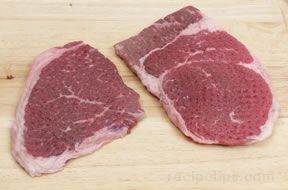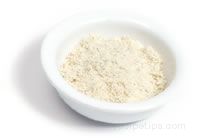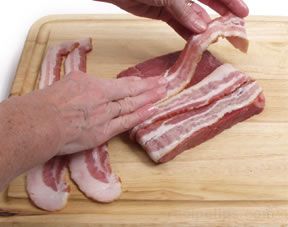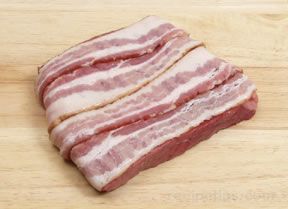Pounding | Commercial Powders | Marinating | Rubs | Barding
| Tenderizing makes it possible to purchase less costly beef cuts and still enjoy the tenderness that is usually found only in the more expensive cuts. Tenderizing methods allow some of the tougher cuts of beef to be cooked with high heat methods such as grilling and broiling, which are usually reserved for tender cuts. Described below are some of the most commonly used methods for tenderizing beef. |
Pounding
|
Tougher cuts of beef can be tenderized by pounding thin slices into even thinner slices, using a meat mallet. The pounding action flattens the meat and breaks up some of the fibers and connective tissues, making the beef a bit more tender. |
 |
| Cooking the tenderized beef rapidly with high heat cooking methods is an important factor in keeping the meat tender. The flattened beef slices may be broiled, grilled, or sautéed, which provide excellent results. |
 |
Commercial Powders
|
A powdered meat tenderizer can be purchased and sprinkled on tougher cuts of beef. The tenderizing powders contain enzymes that help break down the tougher fibers of the meat. The enzymes are often produced from pineapple and papaya extracts. |
 |
Marinating
|
Another option for tenderizing beef is with the use of a marinade. Soaking various cuts of beef in a marinade is a good method for adding flavor as well as to help tenderize the meat. |
|
A proper marinade should contain an acidic ingredient such as vinegar or wine, oil such as olive oil, and seasonings such as herbs and spices. Citrus fruit juices may be used in place of the vinegar or wine to provide the acidic ingredient that is necessary to soften the tissues of the meat.
Fresh pineapple juice is an excellent ingredient for a marinade because it contains one of the most powerful natural tenderizers, the enzyme bromelin, which is very efficient in breaking down protein. This enzyme is destroyed if it is heated, so when using pineapple juice for the purpose of tenderizing meat, the juice must be fresh. (Any previously cooked or canned pineapple juice has no effect on tenderization.) |
 |
|
There are several important points to remember when using a marinade:
- Quantity: The marinade should totally cover the meat in order for it to work effectively.
- Soaking Time: When using tender cuts of beef, a soaking time of 2 hours or less is all that is required because the marinade is used basically to flavor the meat. Tougher cuts of beef should be soaked in the marinade for several hours or overnight in order to tenderize the meat as well as flavor it.
- Refrigeration: Always marinate beef in the refrigerator.
- Proper Containers: Since the marinade contains an acidic ingredient, reactive containers such as metal bowls should not be used. It is best to use containers such as glass or plastic bowls or plastic bags that can be sealed.
- Reuse: The marinade should not be reused for any other purpose because of the bacteria that may be present from having been in contact with the raw meat. The only way the marinade can be reused is to boil it thoroughly to be used as a basting liquid or as part of a sauce for the meat.
|
Rubs
|
An additional option for tenderizing beef, as well as adding flavor to it, is with the use of a rub. A dry mix of herbs and spices are applied to the raw beef and are allowed to permeate and flavor the meat over a period of time, usually overnight in the refrigerator. An endless variety of rubs can be prepared for beef depending on the types of flavors that you want to add to the meat.
- Application: A rub mixture can be rubbed onto the meat, but the moisture from the meat can cause the dry ingredients to stick to your hands. The best results often occur when the ingredients are sprinkled evenly on all sides.
- Ingredients: Some of the ingredients that may be used for a dry rub include black pepper, cumin, chili powder, crushed red pepper, celery seed, garlic powder or fresh crushed or minced garlic, salt, and brown sugar.
- Paste Rub: A small amount of liquid may be added to the mixture in order to create a dry paste, which may be preferred in some cases. Some of the liquids that are often used are vinegar, cider vinegar, wine, or fruit juice.
- Sugar Usage: Use sugar sparingly because it will melt and burn during the cooking process, especially if the beef is grilled or broiled. Too much of the burnt sugar will provide unpleasant results. Only a small amount of sugar is necessary to provide adequate flavor.
- Results: Both the dry rub and the paste will form a flavorful crust when the beef is cooked. Rubs are most often used with beef ribs that will be grilled or barbecued, but they can be used with almost any cut of beef.
|
Barding
|
Barding consists of wrapping thin layers of beef fat or bacon around cuts of beef. Some of the fat melts during the roasting process, which adds moisture and flavor to the meat and serves as a natural tenderizer. The remaining fat can be removed after the meat is cooked.
If you plan to roast a lean, tough cut of beef rather than braise it, then barding may be beneficial. Lean cuts of beef, such as cuts from the round, which are among the muscles responsible for locomotion, are usually tough because often used muscles are less tender than seldom used muscles. Muscles that are constantly worked also lack internal fat, known as marbling.
Suspension muscles from the center of the animal, located in the rib and loin area, are very tender because they do not move as much as muscles in the front or rear portions of the animal. As a result, beef cuts from the loin and rib never require barding. |
 |
 | |






